The many faces of snowstorms
Science explains why some storms quietly dust us with flakes while others howl ferociously
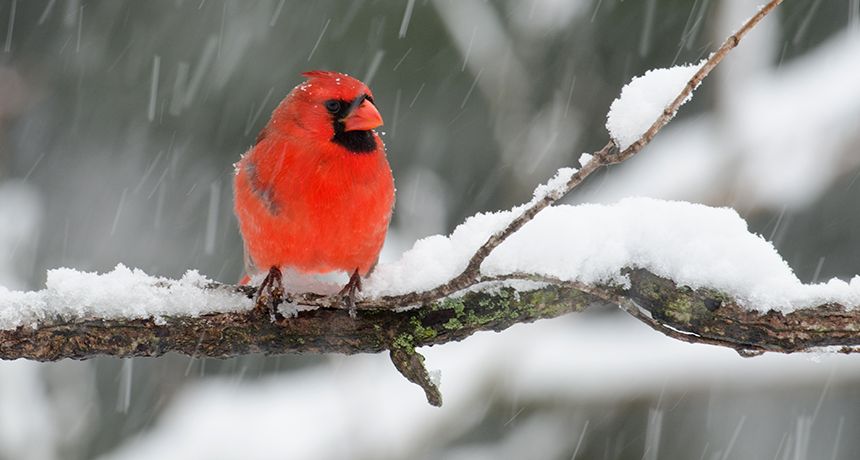
A cardinal weathers a snowstorm. Note the small size of the snowflakes accumulating on the bird’s head. That indicates a temperature likely several degrees below freezing, when flake size would begin to shrink.
EEI_Tony/iStockphoto
Most people love a good snowstorm. After all, what’s better than a day off from school or work to sip warm cocoa as you wait for a chance to later explore the imminent winter wonderland? But just as no two snowflakes are alike, neither are any two snowstorms.
Many conditions give rise to snow. How and where they develop can make the difference between whether they drop a quiet dusting or the proverbial Snowmageddon.
Consider a late January 2016 storm that hit the U.S. East Coast from the mid-Atlantic states up to New England. In and around the nation’s capital, Washington, D.C., it dropped some 61 centimeters (24 inches) to more than 102 centimeters (40 inches). The storm also blanketed many New Jersey cities with 76.2 centimeters (30 inches) or so.
All snowstorms require the same ingredients: cold air, moisture and an unstable atmosphere. But winter air tends to be dry. It usually stores little moisture, the main ingredient in snow. That’s why living near a body of water — such as a lake, river or the ocean — can boost the chances that some regions will regularly get blanketed with mountains of flakes.
And while most snowstorms are relatively quiet, there are the occasional boomers. Scientists refer to these as thundersnows. Rare conditions can cause static electricity to build up within snow clouds and nearby structures. If a discharge occurs, the lightning can trigger a rumbling thunderclap.
The role of moisture
In some cases, one town might be buried beneath snow while the next neighborhood over remains dry. This often happens where the source of moisture for a winter storm is very localized — such as a lake. No surprise, such storms deliver what is known as lake-effect snow.
As winter approaches, chilly air can blow over water that still is fairly warm. This often occurs in November and December at sites where northern states border the U.S. Great Lakes. As streams of cold air flow in, lake water can heat up pockets of air near the surface. That air rises to form clouds. The phenomenon is similar to why you see your breath on cold days. The air you exhale is relatively warm and humid, so it briefly forms a cloud.
Eventually this air will cool, allowing its moisture to condense. Suddenly, flakes can begin to fly fast and heavy — and not let up for hours, days or even a week.
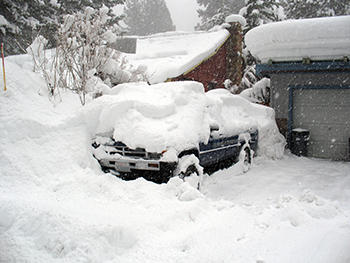
For maximum snow, the wind has to be just right. If it blows lengthwise along the lake, it ups how long a cloud can build, sopping up moisture. Once that cloud moves inland, it loses its fuel source (the lake’s water) and disintegrates. That’s why the affected communities may lie no more than 24 kilometers (15 miles) from a lake’s shore. Areas farther inland might see no more than a few flurries.
Compared to the monster winter storms that can spin up off the U.S. East Coast, bands of lake-effect snow tend to be quite small. Most are the size of a typical summer thunderstorm — only 10 to 20 kilometers (6.2 to 12.4 miles) across.
But lake-effect storms can be intense, dropping up to 15 centimeters (6 inches) of snow per hour. If the clouds tower high enough, thunder and lightning may develop. This thundersnow can be quite common in parts of upper New York, along the edges of Lakes Erie and Ontario. Once in a while, these tall wintertime clouds even drop small hail amidst the snow and thunder. Usually, the hail stones are smaller than the size of a pea.
Lake-effect snows, there, have racked up mind-boggling totals. From November 17 to 19 in 2014, a persistent lake-effect snowstorm settled over the southern suburbs of Buffalo, N.Y. It dropped 1.52 meters (5 feet) of snow. This storm led to 13 deaths, not to mention hundreds of collapsed roofs. The National Weather Service described the prolonged storm as one that just “didn’t budge.”
Equally impressive was how localized the precipitation was by November 18, midway through the storm. “The wall of snow was still quite apparent with blue skies to the north and zero visibility on the other side,” reported the National Weather Service office in Buffalo. “[T]here were only a few inches on the ground at Genessee Street, but several feet of snow . . . less than two miles [3.2 kilometers] south.”
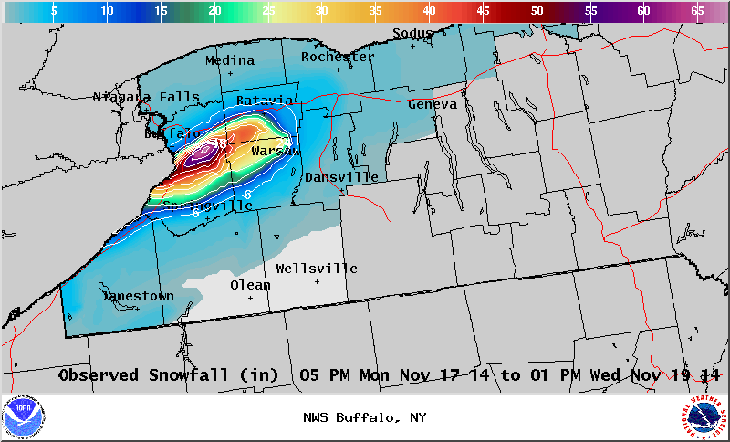
One day later, another storm just 16 kilometers (10 miles) to the south dropped more than a meter (4 feet) of snow on neighboring communities. Some sites in between were hit by both storms and ended up trapped beneath more than 2 meters (7 feet) of snow.
Squalls
Storms that line up along a front are known as snow squalls. These may form just about anywhere. All they need is a strong temperature gradient — variation in temperatures — near the ground along some broad mass of cold air. This encroaching cold front brings cool, dense air. The incoming cold air thrusts upward the slightly warmer and moister air in front of it. This can set up a line of brief but heavy snows along the front edge of the incoming cold front.
Boundaries between air masses having different temperatures or humidity are a great source of lift — upwardly moving air. Any snow storms that develop here can now tap into strong winds high above the ground. A sudden squall could now sweep in and catch towns off-guard with briefly heavy snow and powerful wind gusts. Such squalls have been to blame for many large-scale traffic snarl-ups.
One noteworthy example occurred near Climax, Mich., on January 9, 2015. A quick incoming squall blew through a stretch of Interstate 94. It left a 193-car pileup in its wake. The wreckage was strewn along a 400-meter (quarter-mile) path. The accident spurred a fuel leak in a tractor-trailer. When it caught fire, the scene lit up with fireworks. Literally. The truck had been hauling a 18,140-kilogram (40,000-pound) payload of firecrackers.
In 2019, the National Weather Service developed and implemented a new “Snow Squall Warning.” It’s issued for short-triggered events like this and covers very localized areas. It preempts radio coverage, activating the Emergency Alert System to make sure everyone in the path is notified. Such alerts have been issued several times already this year.
Blizzards
The scariest of winter storms is the blizzard. These howling monsters are defined by their heavy, unremitting winds. To qualify as a blizzard, a snowstorm must blow with sustained winds of 56.3 kilometers (35 miles) per hour or deliver frequent gusts of that intensity. Such conditions also must last for at least three hours, according to the National Weather Service.
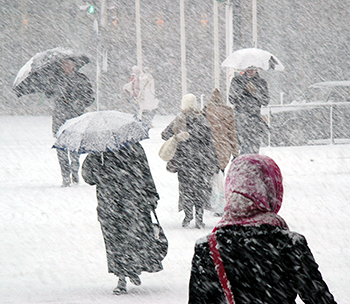
Blizzards develop when several different weather systems “stack” atop each other.
First, a zone of low pressure starts to become organized near to the ground. This must occur just in front of an upper-level dip in the jet stream — a fast river of air that flows high above Earth’s surface. This mix of conditions helps spin up a storm by causing the air ahead of the upper-level dip to rotate. A stronger area of low pressure above, meanwhile, acts as a vacuum to remove air from above. This helps the surface storm intensify. As the two weather systems approach each other, the surface storm intensifies until the two systems merge into one ferocious beast. Once the storm systems are “vertically stacked,” they will have reached peak intensity.
The lower the air pressure, the more intense the storm. That’s because the lack of air density draws in more nearby air. This speeds up the wind. (It’s also the explanation for why hurricanes have a clear eye and a staggeringly low air pressure.)
What makes a cyclone or blizzard so special is how rapidly a region’s air pressure drops. At sea level, the air pressure tends to hover around 1,015 millibars. A drop of a few millibars can signal bad weather is on its way. Some blizzards undergo a process called bombogenesis. This refers to a startling, one-day fall of 24 millibars in the storm’s central air pressure.
On December 9, 2005, a whopper of a storm developed in New York off the coast of Long Island. As it moved north toward Cape Cod, Mass., the storm strengthened. At one point, the local air pressure dropped an amazing 13 millibars in just three hours.
Such a sharp drop in air pressure reflects the movement of air up and out of the storm’s center. With a diminished column of air above the ground, that mass of air now weighs less. And that’s why the pressure (or force of air on the ground) drops.
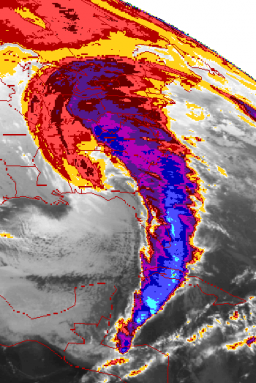
The massive pressure drop revved this storm into a monster. It unleashed “microbursts” — winds that gusted to 161 kilometers (100 miles) per hour. There also was a barrage of winter waterspouts and thundersnow. A plane landing at Boston’s Logan Airport was even struck by the storm’s lightning.
At coastal sites, a blizzard’s twirling winds can pull in warmer air from the ocean. What later falls out in areas near to the coast may be rain, freezing rain, sleet — or an ugly mix of them. Indeed, that ocean layer makes it difficult to forecast what the precipitation here will be.
Blizzards often feature a warm side to their south. Here, a slug of moisture can create a line of damaging showers and thunderstorms. One massive system went down in the books as the “Storm of the Century” on March 13, 1993. On the north side, snow fell. But to the south, a damaging thunderstorm line developed — one that spawned 11 tornadoes that savaged parts of Florida.
When these sprawling storm systems develop off the U.S. East Coast, meteorologists will refer to them as “nor’easters.” Much of their strengths comes from the warmer air over the Gulf Stream’s lukewarm waters. That’s because the wind starts off blowing in from the northeast. Later, if storm races on into Canada’s Maritime provinces, the winds can abruptly pivot. They now can come in from the northwest. This switcheroo draws in much colder, drier air — sometimes even spurring a “flash freeze.” Most nor’easters occur in the cold season and produce snow, frequently leading to blockbuster storms.
Winter can wallop communities with surprising weather. Understanding the science behind snowstorms helps to explain why each one challenges the ability of forecasters to tell us what to expect.







